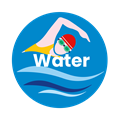Paddling in open water
Age:
4+

Explore lakes, rivers and the sea
Paddling in open water offers all the fun of taking a dip in a pool, as well as the added thrills of jumping in the sea, discovering the natural world and maybe seeing fish swim at your feet.
Overview
Girls can paddle in the sea, lakes and other open water. To take girls paddling, you'll need to find a safe local venue.
Paddling in open water is defined as entering water to no more than knee depth – any deeper than this is regarded as swimming and you must follow the swimming in open water guidance.
Approved: 16 March 2022
Version: 1.1
Content owner: Adventure team
Planning checklist
If you or another member of your leadership team is running the activity at an external venue/location, follow these extra steps:
- Arrange for a home contact. Leave any route or other relevant details with your home contact and complete a home contact agreement form. Let them know about any changes to your plans.
- Tell your commissioner.
- Consider the ability and experience of the participants and any disabilities, access needs or health conditions and plan the session accordingly.
We recommend at least one adult with up-to-date knowledge of water safety and rescue techniques, such as the Girlguiding water safety training module.
A lifeguard must be considered as part of the risk assessment.
Finding a lifeguard
Contact your local swimming club, the Royal Life Saving Society (RLSS) or the Swimming Teachers' Association (STA) for information on booking a lifeguard.
The leader must:
- Make sure that safety rules and alarm signals have been explained to the girls. And that girls understand that they need to follow instructions immediately.
- Follow water safety guidelines and make sure that the responsible adult helpers are familiar with them.
- Arrange appropriate lifeguard cover and sufficient responsible adult helpers based on the number of paddlers and their section, the ability of the participants and the type of water.
- Discuss their responsibilities with the lifeguards and adult helpers and make sure that safety equipment is provided.
- The depth of the water should be checked in advance to make sure that suitable boundaries for the activity can be set. This is particularly important where the bottom may shelve steeply.
Lifeguards must be satisfied that the conditions on the day are suitable for safe paddling, taking into account:
- Local advice
- The weather conditions
- The location and temperature of the water
- The age, ability and state of health of the paddlers
- Natural hazards, for example weeds, rocks, state of the tide and any visible pollution (chemical or rubbish)
Paddlers must:
- Be paired up, stay in these pairs and be responsible for watching each other using the 'buddy' system
- Enter the water gradually and come out of the water if they start to get cold
The ratios below are given as a maximum and ratios must be considered as part of the risk assessment, this may lessen due to any medical conditions, physical ability or other factors.
Leadership team ratio
As this activity will take place outside of your usual meeting place the leadership team adult to child ratio is mandatory.
- Rainbows: 1:5, at least 2 adults
- Brownies: 1:8
- Guides: 1:12
- Rangers: N/A, with leader permission
Both Guides and Rangers may go paddling without a leader. However, Guides must be accompanied by another responsible adult (who has been approved by the leader) and for both sections they must have permission from their leader.
Qualified adult/participant ratio
We recommend at least one adult with up-to-date knowledge of water safety and rescue techniques, such as the Girlguiding water safety training module.